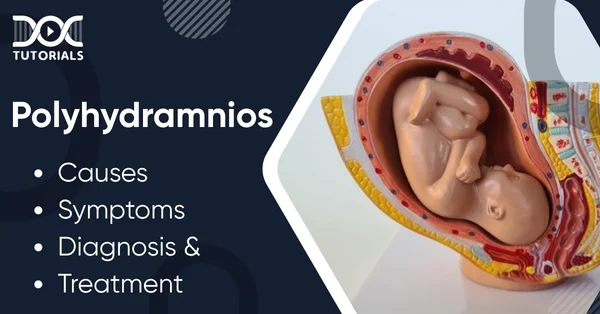Polyhydramnios: Causes, Symptoms, Diagnosis, and Treatment

Polyhydramnios is a relatively uncommon, however, complex condition that may arise during pregnancy, caused by excessive accumulation of amniotic fluid in the uterus. Ranging from mild to severe, polyhydramnios can be caused by a variety of factors, including maternal diabetes or fetal abnormalities.
Accurate diagnosis, risk stratification, and appropriate management are essential to optimising maternal and fetal outcomes. If you’re an aspiring NEET PG medical student, read ahead to understand what causes excess amniotic fluid, its pathophysiology, the diagnostic approach, and evidence-based management strategies.
What Does Polyhydramnios Mean?
Polyhydramnios develops when there is too much amniotic fluid during pregnancy. It occurs in approximately 1–2% of pregnancies and is detected by ultrasonography when the amniotic fluid index (AFI) is 24 cm or greater, or the deepest vertical pocket (DVP) is 8 cm or greater.
We can tell what kind of condition this is by looking at the following:
- The range for mild polyhydramnios is an AFI (amniotic fluid index) of 24 to 29.9 cm.
- Moderate polyhydramnios range: AFI between 30 and 34.9 cm.
- Severe polyhydramnios range: AFI ≥ 35 cm
Mild polyhydramnios is commonly idiopathic and may not lead to bad consequences. However, moderate to severe instances require thorough evaluation and close monitoring.
What Causes Polyhydramnios?
Polyhydramnios is a condition in which too much amniotic fluid builds up during pregnancy. It can happen because of several things that happen to the mother and the baby, such as the ones listed below:
- Gestational Diabetes Mellitus (GDM): High blood sugar levels in the mother create high blood sugar levels in the foetus, which leads to polyuria and more amniotic fluid.
- Maternal Infections: Toxoplasmosis, cytomegalovirus, and parvovirus B19 are examples of infections that might affect how the foetus swallows.
- Problems With Swallowing: Conditions such as oesophageal atresia, anencephaly, and diaphragmatic hernia make it difficult for a foetus to swallow, causing fluid to accumulate.
- Genetic Syndromes: Trisomies 13, 18, and 21 can cause polyhydramnios because of different structural problems.
- Neurological Disorders: Problems with the central nervous system might make it hard to swallow.
- Intrauterine infections, such as rubella, cytomegalovirus, and herpes simplex virus, may cause the body to produce more amniotic fluid.
- Idiopathic: About half of all polyhydramnios cases don’t have a known cause.
Polyhydramnios can happen when a woman has gestational diabetes or when the growing fetus’s digestive tract, central nervous system, or other organs are affected.
What are the Signs That Someone Has Polyhydramnios?
Polyhydramnios can cause anything from slight pain to significant problems. Here are some of the most prevalent signs and symptoms of polyhydramnios:
- Abdominal pain or swelling
- Shortness of breath because of an elevated diaphragm
- Swelling in the feet
- Contractions in the uterus or early labour
- Hard to feel foetal parts
What are the Problems That Come with Polyhydramnios?
Polyhydramnios can cause a lot of problems, such as:
- Preterm labour
- Premature rupture of the membrane
- Foetal malposition
- Abdominal pain
- Heartburn
- Pedal oedema
- Swallowing issues
- Breathing difficulty for the mother
- Postpartum haemorrhage
It can also cause problems for the infant, including:
- Stillbirth
- Neonatal respiratory disorders
- Congenital anomalies
- Umbilical cord prolapse
How Can You Know If You Have Polyhydramnios?
There are several tests that can accurately find polyhydramnios during pregnancy. The following things are done to do more clinical tests:
- Ultrasound: The main way to make a diagnosis. Polyhydramnios is confirmed by an AFI of 24 cm or more or a DVP of 8 cm or more.
- Foetal Assessment: A detailed look at the baby’s anatomy to find any structural problems.
- Maternal Testing: Checking for infections and GDM.
What are the Many Ways to Treat Polyhydramnios?
How bad polyhydramnios is and what caused it will determine how it is treated. In mild cases, merely watching may be enough. In severe cases, medicines or amnioreduction may be needed. Here are some popular ways to address this condition:
For Mild Polyhydramnios
- Regular monitoring often makes things better, and no intervention is needed if there are no symptoms and no foetal defects are found.
For Moderate to Severe Polyhydramnios
- Amnioreduction: Amniocentesis is a medical procedure that removes amniotic fluid to help the mother feel better and reduce the size of the uterus.
- Therapy With Drugs: Indomethacin is a nonsteroidal anti-inflammatory medicine that can lower the amount of urine a foetus makes. However, its usage is limited because it could have negative consequences on the foetus, and not everyone agrees with it.
- Dealing With the Root Causes: Taking care of a mother’s diabetes or infections can help keep the amniotic fluid levels stable.
- Planning for Delivery: In serious circumstances or when problems come up, early birth is best.
FAQs about Polyhydramnios
- What makes there be too much amniotic fluid?
Too much amniotic fluid can be caused by maternal diabetes, foetal abnormalities that make it hard to swallow, infections, or it could just be idiopathic. - What is the range for mild polyhydramnios?
An AFI of 24–29.9 cm or a DVP of 8–11 cm means that a person has mild polyhydramnios. - What does polyhydramnios do to the baby?
Polyhydramnios can cause foetal malpresentation, umbilical cord prolapse, a higher chance of caesarean birth, infant respiratory distress, and low blood sugar. - What problems might polyhydramnios cause?
Some problems that can happen are early labour, membranes breaking too soon, placental abruption, bleeding after giving birth, and foetal macrosomia. - What are the treatments for polyhydramnios?
The treatment for polyhydramnios depends on how bad it is and what caused it. In mild situations, all that may be needed is monitoring. In severe cases, amnioreduction or pharmacologic therapy may be needed. It is also very important to deal with underlying issues in the mother.
Conclusion
Polyhydramnios is a multifactorial condition with varying clinical implications. Understanding its aetiology, diagnostic criteria, and management options is essential for optimal maternal and fetal outcomes.
Are you preparing for the NEET PG exam and want to master polyhydramnios? DocTutorials offers comprehensive study material, expert video lectures, a quick revision program, and interactive quizzes to help you easily understand complex medical concepts.
Join DocTutorials now and excel in your preparation!
Latest Blogs
-

NEET SS Exam 2024: Analysis, Key Dates, Counselling
The NEET SS 2024 exam kicked off on March 29, 2025. Over two days and two slots, candidates across 13…
-

NEET PG Registration 2025: An Essential Guide For Exam Prep
The NEET PG registration, which is conducted online, is a crucial step in the exam process. Filling out the NEET…
-

NEET PG Syllabus 2026: A Must-Have Complete Guide for Exam Success
The NEET PG Syllabus acts as one of the foundation stones for aspiring postgraduate medical students like you who are…




